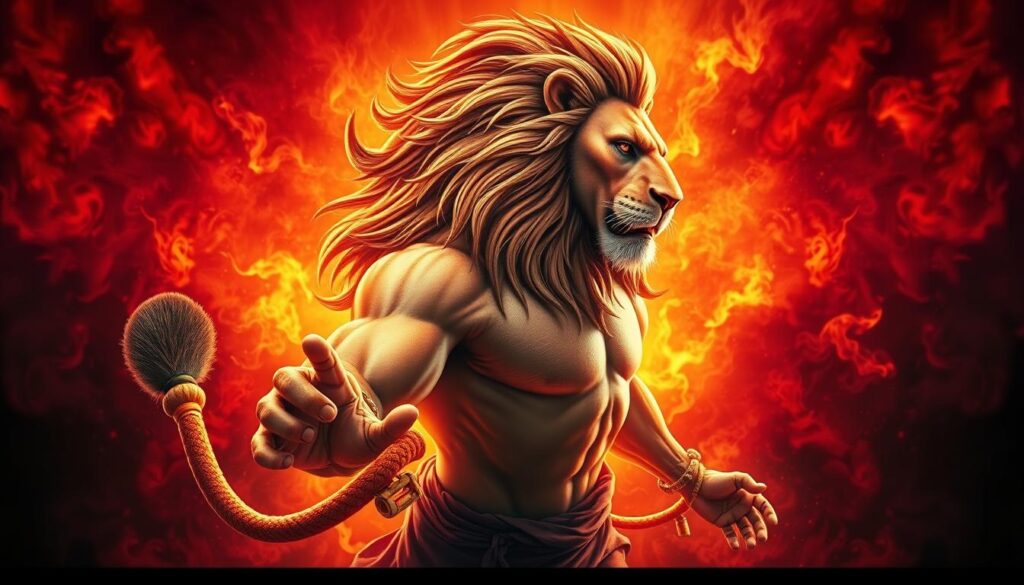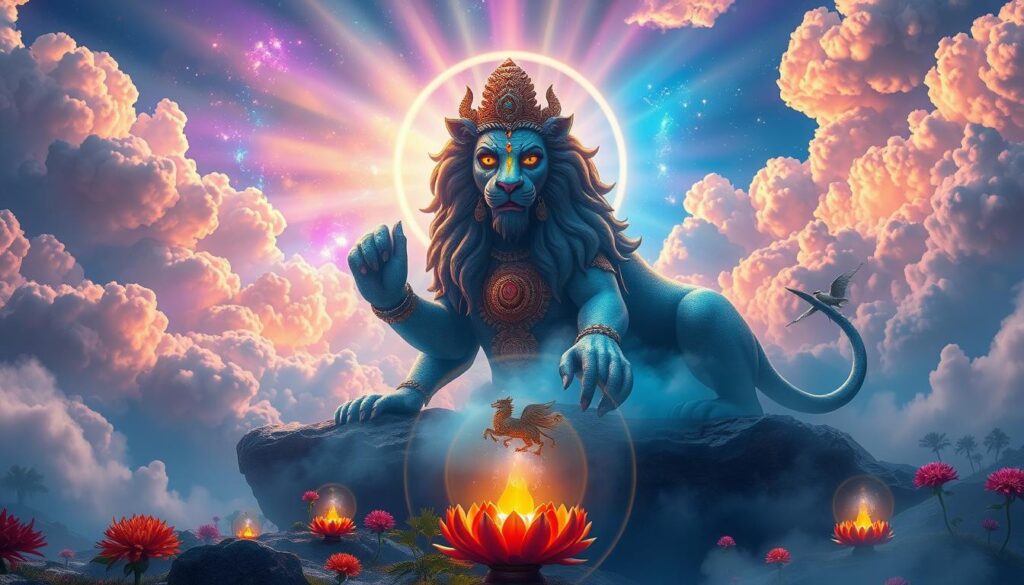The Narasimha avatar story is a key part of Hindu mythology. It’s known for its unique form and the tale of Hiranyakashipu and Prahlada. This story is one of the 10 avatars of Lord Vishnu.
These avatars include Matsya, Varaha, Koorma, Vamana, Narasimha, Rama, Parasurama, Krishna, Balarama, and Kalki. The Narasimha avatar is a half-man, half-lion form of Lord Vishnu. It symbolizes the power and protection of the divine.
The story teaches us about faith, devotion, and justice winning. The Narasimha avatar is a key part of Hindu mythology. It’s celebrated in many temples, mainly in Ahobilam, Andhra Pradesh.
The Narasimha avatar story shows the lasting power of faith and devotion. It’s a significant figure in Hindu mythology. The story of Hiranyakashipu and Prahlada is inspiring and captivating.
The Narasimha avatar reminds us of the importance of justice. It shows good can triumph over evil. Its significance will be felt for many generations, making it a vital part of Hindu mythology.
Introduction to Narasimha Avatar
The Narasimha Avatar is a key form of Lord Vishnu in Hindu stories. It is linked to Prahlad, a big fan of Lord Vishnu, and Hiranyakashipu, a bad king. Hiranyakashipu wanted to kill his son because he loved Lord Vishnu too much.
This avatar is the fourth form of Lord Vishnu. It saved Prahlad from Hiranyakashipu’s harm. The Narasimha story is found in the Bhagavata Purana and other Puranas. It shows how important it is in Lord Vishnu’s stories.
What is the Narasimha Avatar?
The Narasimha Avatar looks like half-man and half-lion. Lord Vishnu took this form to defeat Hiranyakashipu. This way, Lord Vishnu could get around Hiranyakashipu’s special protection.
Importance in Hindu Mythology
The Narasimha Avatar is very important in Hindu stories. It shows good winning over bad. The story of Narasimha inspires many, teaching about love, protection, and fighting against evil.
Many celebrate the Narasimha Avatar in festivals like Holi. It is also honored in many temples in India.
The Backstory of Hiranyakashipu

Hiranyakashipu was a powerful demon king. He was born to Diti and sage Kashyapa in the Satya Yuga. He did severe penance for years to get a boon from Lord Brahma.
This boon made him almost invincible. It said he couldn’t be killed by man, beast, devil, or god. It also said he couldn’t be killed at day or night, with steel, stone, wood, indoors, outdoors, in earth, or in sky.
He wanted to be immortal for ultimate power and control. Symbolism helps us understand Hiranyakashipu. His actions show our desire to be invincible.
The half lion half man form of Narasimha shows balance. It’s between human intellect and animal strength.
Hiranyakashipu ruled with a strict rule. He said only he should be worshipped as God. He tried to kill his son Prahlada many times.
Prahlada followed Lord Vishnu with all his heart. His faith led to Hiranyakashipu’s death. Lord Narasimha came from a pillar to defeat the demon king.
The Birth of Prahlada

Prahlada, the son of Hiranyakashipu, was born with a love for Lord Vishnu. This shows the idea of divine incarnation in Hindu mythology. His birth and upbringing are key parts of the Narasimha Avatar story, showing the battle between good and evil.
Prahlada showed his divine side from a young age. Lord Narada taught him spiritual lessons before he was born. This early learning deeply influenced Prahlada’s life, affecting his relationship with his father and the world.
Prahlada’s Relationship with His Father
Prahlada and Hiranyakashipu had a complicated relationship. Prahlada’s love for Lord Vishnu clashed with his father’s wishes. Hiranyakashipu, who was immortal, saw Prahlada’s devotion as a threat to his power.
Prahlada’s story teaches us about the strength of devotion. His bond with his father shows the lasting themes of Hindu mythology. These include the fight between good and evil and the idea of divine incarnation.
The Anger of Hiranyakashipu
Hiranyakashipu’s anger grew as his son Prahlad’s love for Lord Vishnu deepened. The king’s rage was driven by his own dreams and fear of losing power. He saw Prahlad’s faith in Lord Vishnu as a danger to his rule.
The king tried many ways to kill his son. But every time, something divine stopped him. This made Hiranyakashipu even angrier. The fight between Hiranyakashipu and Prahlad got worse, with the king’s hatred for Lord Vishnu growing.
The tale of Hiranyakashipu and Prahlad shows the strength of faith and devotion. Despite facing harsh punishments, Prahlad’s faith in Lord Vishnu never wavered. This led to Hiranyakashipu’s downfall and the victory of good over evil. The story of Prahlad and Lord Vishnu inspires many to this day.
The Rise of Lord Vishnu’s Narasimha Avatar
![]()
The Narasimha avatar story is a key part of Hindu mythology. It shows the victory of good over evil. Lord Vishnu became a half-man, half-lion to defeat the demon king Hiranyakashipu.
This form was chosen to beat Hiranyakashipu’s special boon. It made him almost unbeatable.
The symbolism of the Narasimha avatar is deep. It shows the balance between human and animal sides. The half-man, half-lion form means divine power beyond normal limits.
The Narasimha avatar story tells us truth wins over lies. It shows the power of faith and devotion.
The Narasimha avatar is important in art and festivals. Narasimha Jayanti is on the 14th day of the bright half of the lunar month. It celebrates Lord Vishnu’s Narasimha form.
The story of Narasimha reminds us of divine protection for the faithful. It teaches us to be humble and devoted to overcome hard times.
The Confrontation with Hiranyakashipu
![]()
In Hindu mythology, Narasimha Avatar is a key story. It shows Lord Vishnu’s divine form. The fight between Narasimha and Hiranyakashipu is a major part of this tale.
Hiranyakashipu, a demon king, got a special boon from Lord Brahma. This made him almost unbeatable. But Narasimha, Lord Vishnu’s form, found a way to beat him. This shows the cleverness and power of the divine.
The Shadow of Boons
Hiranyakashipu thought he was invincible because of his boon. But, this made him too sure of himself. Narasimha used this to his advantage, finding ways to beat the demon king.
The Divine Strategy of Narasimha
Narasimha’s plan was smart. He knew the boon’s rules and Hiranyakashipu’s weaknesses. By showing up at the palace door, Narasimha beat Hiranyakashipu without breaking the boon. This story shows how cleverness and divine help are key in Hindu tales.
The battle between Narasimha and Hiranyakashipu is a big deal in Hindu stories. It shows Lord Vishnu’s power and cleverness. This tale reminds us of the value of faith and devotion in facing big challenges.
The Epic Battle
The Narasimha avatar story is a key moment in Hindu mythology. It shows Lord Vishnu’s divine power. Narasimha, half lion half man, changed the battle between good and evil.
The battle happened at twilight, a time between day and night. It was between Hiranyakashipu and Prahlada. This was a fight over who was right, the parent or the devoted follower.
Narasimha came with a loud roar. This showed his fierce side as a protector. He defeated Hiranyakashipu, proving good can win over evil.
- Narasimha emerged at twilight, a time between day and night
- He used his claws to defeat Hiranyakashipu, showing divine justice
- Narasimha’s victory brought back cosmic order (dharma), showing good can win over evil
The Narasimha avatar story teaches us about faith and devotion. Narasimha, half lion half man, inspires many. His story is a big part of Hindu mythology.
The Climactic End of Hiranyakashipu
The story of Hiranyakashipu’s end is key in Hindu mythology. It’s full of symbols and shows the idea of divine incarnation. Narasimha, a half-man, half-lion form of Lord Vishnu, killed Hiranyakashipu at his palace door. This door was not fully inside or outside.
This event is important because it meets Hiranyakashipu’s special protection. The protection said he could not be killed by humans, gods, or animals. It also said he could not be killed during the day or night, on land, in water, or in the air. Narasimha’s actions show he understood the deep meanings of Hindu myths and the power of divine incarnation.
The threshold in this story is very interesting. It’s a place that is neither fully inside nor outside. This is key to the story. It lets Narasimha defeat Hiranyakashipu, bringing balance back to the world. Narasimha’s victory over Hiranyakashipu shows good can win over evil in Hindu myths.
The story of Hiranyakashipu’s death reminds us of the value of faith and the dangers of pride. It also shows the complex nature of divine justice and the balance between good and evil. Through Hindu mythology and symbolism, this story gives us insights into human nature and the role of divine incarnation in our world.
Prahlada’s Redemption
Prahlada’s journey shows the strength of faith and devotion. As Hiranyakashipu’s son, he faced many challenges and threats. But he never gave up his love for Lord Vishnu. His faith saved him, thanks to the divine incarnation of Narasimha.
The story of Prahlada teaches us about forgiveness and faith. Despite his father’s torture, Prahlada forgave and kept worshiping Lord Vishnu. His story shows the value of devotion and sticking to our beliefs, no matter what.
Some key lessons from Prahlada’s journey are:
- The power of faith and devotion in overcoming adversity
- The importance of forgiveness and letting go of negative emotions
- The rewards of standing by one’s beliefs and values
Prahlada’s story is a powerful example of faith and devotion’s impact. His strong commitment to Lord Vishnu and the divine incarnation of Narasimha helped him conquer great challenges. He found redemption.
The Legacy of Narasimha Avatar
The Narasimha avatar story is a big part of Hindu mythology. It shows the victory of good over evil. This tale has deeply influenced Hindu culture, shaping art, literature, and worship.
The Narasimha avatar is seen as a fierce protector. It stands for dharma (cosmic order) and fights against adharma (disruption and evil).
Worship and Festivals Celebrating Narasimha
In Hindu mythology, Narasimha is celebrated in many festivals and worship practices. Temples like Ahobilam in Andhra Pradesh and Simhachalam in Odisha have detailed sculptures of Narasimha. The Narasimha Sukta, a hymn, praises Narasimha’s protective nature.
It shows that divine help comes when dharma is at risk.
Influence on Artistic Representations
The Narasimha avatar has inspired many artworks, like sculptures, paintings, and literature. Its themes of good vs. evil, divine justice, and faith’s importance are seen in art.
Modern Interpretations of the Narasimha Story
The Narasimha avatar story is told in many ways today. It keeps its place in Hindu mythology. This story of Lord Vishnu inspires and fascinates people.
Narasimha in Literature and Film
The Narasimha story appears in books and movies. It shows its lasting charm. From old texts to new versions, Narasimha’s tale is a classic.
Contemporary Relevance of the Tale
The Narasimha story’s themes are important today. It talks about good vs. evil, faith, and God’s help. So, Narasimha’s story is key in Hindu mythology, touching hearts of many.
Conclusion: Lessons from the Narasimha Avatar Story
The story of Narasimha Avatar teaches us valuable lessons. It shows the power of faith, staying strong, and the fight between good and bad. Narasimha came when justice was needed, proving that God helps us when we need it most.
Prahlada is a great example of staying true to oneself, even when it’s hard. He never gave up his beliefs, even when his dad was cruel. His story teaches us to hold onto our values and stand up for what we believe in.
The Narasimha Avatar’s victory over evil is a lesson for today. It tells us to find our inner strength and ask for God’s help when we face tough times. The Narasimha Jayanti festival shows how this story continues to inspire people. It teaches us to be brave and have faith in a better future.
